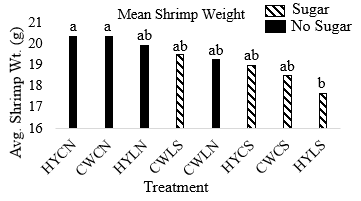THE EFFECTS OF SYSTEM TYPE, SALT FORMULATION, AND SUGAR ADDITIONS ON PACIFIC WHITE SHRIMP Litopenaeus vannamei PRODUCTION, DIGESTIVE ENZYME ACTIVITY, AND DISSOLVED MINERAL COMPOSITION
The use of a low-cost, homemade salt mixture may reduce operational costs for inland marine aquaculture producers. Clearwater (CW) RAS is an effective strategy for shrimp production but may have relatively high equipment and operating costs . The use of simpler hybrid systems (HY) may be advantageous as external biofilters maintain water quality, but solids filtration is minimal to help reduce costs. T he addition of sugar in RAS may benefit shrimp growth by making suspended microbes richer in protein, which shrimp can then consume . However, sugar addition can deplete oxygen and generate excessive concentrations of solids. Additionally, increased digestive enzyme activity has been noted in shrimp raised in biofloc systems but has apparently not been studied in HY or CW systems . Measuring changes in mineral concentrations over time may indicate when specific elements need to be supplemented. This study examines the effects of low-cost salt, system type, and sugar addition on the production, water quality, digestive enzyme activity of L. vannamei, and dissolved mineral composition.
In this study, two levels of each experimental factor were used. The factors used were s ystem type ( CW vs HY), salt type (Least Cost, L vs Commercial, C), and s ugar (presence or absence of sugar addition: S vs. N). There was a total of eight treatments: HY-L-S, HY-L-N, HY-C-S, HY-C-N, CW-L-S, CW-L-N, CW-C-S, and CW-C-N which had three replicates each and were randomly assigned to 1m3 tanks. All tanks were stocked at 250 shrimp per m3, salinity was maintained at 15 ppt, and sugar was added at 55% of the weight of the feed. DO, pH, temperature, and salinity were measured twice daily, and TAN, nitrite, nitrate, turbidity, total suspended solids, and volatile suspended solids were each measured weekly . At the end of the experiment, the hepatopancreas was removed from 6 shrimp from each tank for digestive enzyme analyses and solids from each tank were collected for mineral composition analyses . Shrimp production data (average individual weight of shrimp, total harvest weight, FCR, growth/week ) were calculated at harvest .
Results from the experiment showed no significant differences in shrimp performance between HY and CW systems. The least cost salt showed similar shrimp performance as the commercial salt mixture. The use of sugar in both HY and CW systems with sugar addition showed a significant negative impact on mean shrimp weights compared to those with no sugar addition. Results from the water quality, mineral, and digestive enzyme analyses are pending. The shrimp production results of this study indicate that low-cost salt mixtures can be adopted successfully by producers and that system type does not seem to have much short-term impact on shrimp performance .
